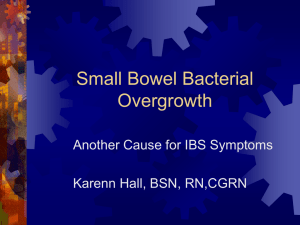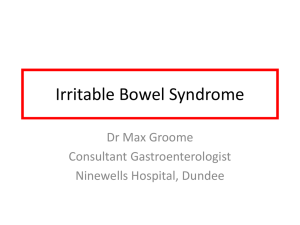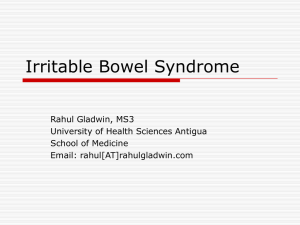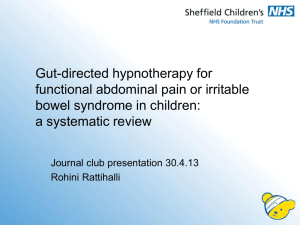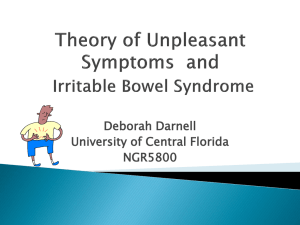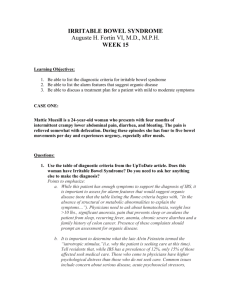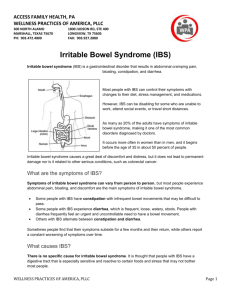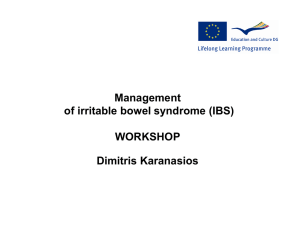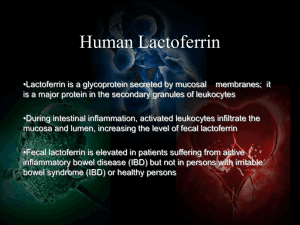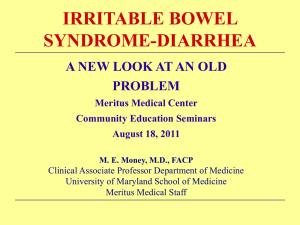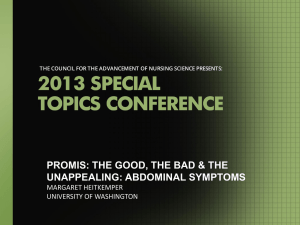Irritable Bowel Syndrome
advertisement
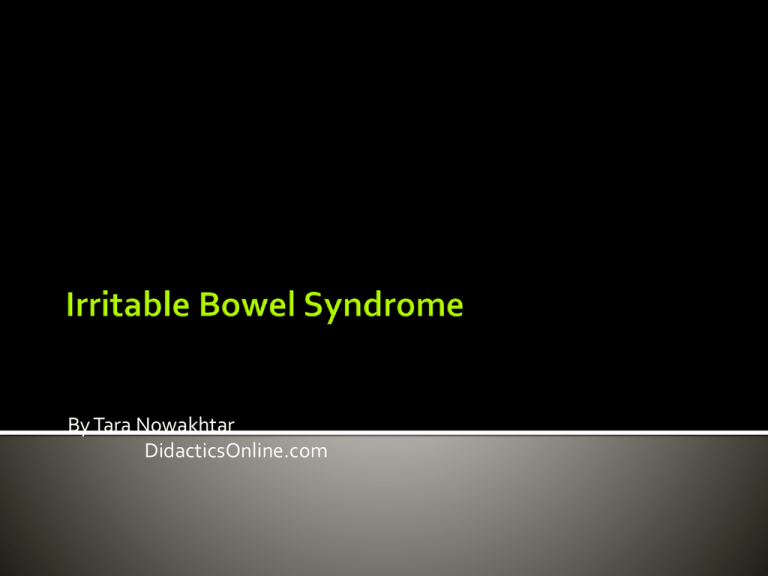
By Tara Nowakhtar DidacticsOnline.com 24 year old female presents with the following symptoms Crampy feeling (abdominal pain), varying intensity, intermittent Stress and eating exacerbate pain Bowel movement relieves pain Alternating diarrhea & constipation Bloated/gassy feeling Gastroesophageal reflux (“heart burn”) Dyspareunia, fatigue Pt has had these symptoms for several days a month in the last 6 months PMHx: depression, anxiety SHx: appendectomy PE: Abdomen tender to palpation in all 4 quadrants with significant guarding Abdomen sounds tympanic on percussion Global fascial tightness throughout abdomen Paraspinal changes at T9-T10 IBS is an intrinsic colonic motility disorder with several plausible causes: loss of tolerance to GI flora, genetic factors, environmental triggers MC functional bowel disorder F>>M Risk factors: Hx of childhood sexual abuse Domestic abuse in women Increased stress, depression, anxiety No pathognomonic pattern of gut dysmotility can be identified with IBS, unlike other functional gut disorders; however, it is suggested that a motility disturbance is the underlying issue in IBS patients Increased sensitivity in the viscera is commonly found in IBS patients Distention - Awareness and pain caused by balloon distention in intestine are experienced at lower volume than with controls Bloating – studies have shown that although there are similar amounts of gas in IBS vs. control patients, there is impaired transit of that intestinal gas Intestinal Inflammation – mucosal immune activation has been shown in IBS, characterized by alterations in immune cells and markers ; mostly in diarrhea predominant Lymphocytes – increased numbers reported in colon and SI in he myenteric plexus Mast cells – in terminal ileum, jejunum, colon; some studies have showed a correlation between abdominal pain and the presence of activated mast cells around colonic nerves Postinfectious IBS – this has been suspected based upon a history of acute diarrheal illness preceding onset of IBS symptoms in some patients GI symptoms: Chronic abdominal pain (crampy, variable intensity) ▪ Emotional stress and eating pain, defecation pain Altered bowel habits Other GI symptoms: ▪ GE reflux, dysphagia, early satiety, dyspepsia, nausea, non cardiac chest pain, abdominal bloating, increased gas (accompanied by flatulence or belching) Non GI symptoms: Impaired sexual function, dysmenorrhea, dyspareunia, increased urinary frequency/urgency Diarrhea Frequent loose stools of small volume, with mucus Generally in the morning or after meals May be preceded by lower abdominal cramps and urgency May have feeling of incomplete evacuation Constipation Days to months; may include bouts of diarrhea or normal bowel function Stools often hard and pellet shaped May sense incomplete evacuation even with empty rectum There are no biologic disease markers for IBS, so diagnosis has been standardized with symptom based criteria Manning Criteria – 1978, not used as much anymore Rome Criteria – 1992, revised 2005, defined as recurrent abdominal pain/discomfort associated with altered defecation Recurrent abdominal pain/discomfort at least 3 days per month in the last 3 months associated with 2 or more of the following: Improvement with defecation Onset associated with change in frequency of stool Onset associated with change in form of stool (appearance) IBS with constipation (hard/lumpy stools predominant) IBS with diarrhea (loose/watery stools predominant) Mixed IBS (neither predominates) Unsubtyped IBS (insufficient stool abnormality to meet the above subtypes) Pain associated with: anorexia, malnutrition, weight loss – these are rare with IBS unless there is severe psychologic illness Progressive pain Pain that prevents sleep or wakes patient from sleep Rectal bleeding Lab abnormalities: anemia, inflammatory markers, electrolyte disturbances These are “alarm” symptoms and require additional testing! Keep in mind: IBS can look like other illnesses, and other illnesses can look like IBS! Dietary modification: pt may have food allergies, should exclude gasproducing foods, coffee, fatty foods, carbohydrates (sx may be related to impaired absorption of carbohydrates: FODMAPs enter distal small bowel and colon when they are fermented, leading to sx and increased intestinal permeability, although there have been few studies to demonstrate this); Increase fiber intake (say most studies, although keep in mind that might be an issue for diarrhea-predominant IBS) Patient-physician relationship is important! Physical activity: in a randomized trial, this was examined - Physical activity comprised of 20-6- min of moderate to vigorous activity 3-5x/w – showed improvement in severity of IBS compared with control group Psychosocial therapies: behavioral treatments for those who associate sx with stressors – the goal being to reduce anxiety, among other things **these are to be used as an ADJUNCT to tx** Antispasmodics Antidepressants Antidiarrheal agents Benzodiazepines 5-HT 3 receptor antagonists 5-HT 4 receptor agonists Lubiprostone Guanylate cyclase agonists Mast cell stabilizers Antibiotics Ex: hyoscine, cimetropium, pinaverium (short term relief, LT efficacy has yet to be demonstrated). Can directly affect intestinal smooth muscle relaxation, or via anticholinergic/antimuscarinic properties They reduce colonic motor activity and may improve postprandial abdominal pain, gas, bloating, and fecal urgency. Independent of their mood improving effects, antidepressants have analgesic properties, and therefore may be beneficial in patients with neuropathic pain The assumed MOA with TCA’s and SSRI’s are facilitation of endogenous endorphin release, blockade of NE reuptake (leading to enhancement of descending inhibitory pain pathways), and blockade of the pain neuromodulator (5-HT). TCA’s also slow down intestinal transit time via anticholinergic properties (helpful in diarrhea predominant IBS) Some patients show improvement in sx’s of bloating, abdominal pain or altered bowel habits after use of antibiotics Rifaximin, a nonabsorbable antibiotic, globally improved IBS symptoms in reports of two randomized trials MOA is unclear, may be due to suppression of gas producing bacteria in the colon CONS: Usually, pt has to pay out of pocket due to the outrageous cost of this medication In a 2007 article in Journal of Gastroenterology & Hepatology titled “Treatment of Irritable bowel syndrome with osteopathy: Results of a Randomized controlled pilot study”, it was found that 13 of 19 patients in the group receiving osteopathic treatment had overall improvement of symptoms in 6 months, one was free of symptoms, and the remaining five showed slight improvement In the standard care group, 3/17 subjects noted “definite” improvement, while 10 showed slight improvement. The remaining 3 had worsened sx’s Improvement was statistically significant in favor of the osteopathic treatment group with a p value <0.006 MFR of abdominal fascia OA decompression ANS treatments Treatment of diaphragms (especially thoracoabdominal!) Treat the whole patient! Listen to the patient, make sure to get a good hx: remember, these patients have had it with doctors and are trying to understand their illness, do your best to help them! 1. 2. 3. 4. 5. 6. 7. 8. 9. 10. 11. 12. 13. 14. 15. 16. 17. 18. Longstreth GF, Thompson WG, Chey WD, et al. Functional bowel disorders. Gastroenterology 2006; 130:1480 Swarbrick ET, Hegarty JE, Bat L, et al. Site of pain from the irritable bowel. Lancet 1980; 2:443 Whorwell PJ, McCallum M, Creed FH, Roberts CT. Non-colonic features of irritable bowel syndrome. Gut 1986; 27:37 Hershfield NB. Nongastrointestinal symptoms of irritable bowel syndrome: an office-based clinical survey. Can J Gastroenterol 2005; 19:231 Owens DM, Nelson DK, Talley NJ. The irritable bowel syndrome: long-term prognosis and the physician-patient interaction. Ann Intern Med 1995; 122:107 Gibson PR, Shepherd SJ. Personal view: food for thought--western lifestyle and susceptibility to Crohn's disease. The FODMAP hypothesis. Aliment Pharmacol Ther 2005; 21:1399 Johannesson E, Simrén M, Strid H, et al. Physical activity improves symptoms in irritable bowel syndrome: a randomized controlled trial. Am J Gastroenterol 2011; 106:915 Choi YK, Johlin FC Jr, Summers RW, et al. Fructose intolerance: an under-recognized problem. Am J Gastroenterol 2003; 98:1348 Poynard T, Regimbeau C, Benhamou Y. Meta-analysis of smooth muscle relaxants in the treatment of irritable bowel syndrome. Aliment Pharmacol Ther 2001; 15:355 Eisendrath SJ, Kodama KT. Fluoxetine management of chronic abdominal pain. Psychosomatics 1992; 33:227 Hameroff SR, Weiss JL, Lerman JC, et al. Doxepin's effects on chronic pain and depression: a controlled study. J Clin Psychiatry 1984; 45:47 Pilowsky I, Barrow CG. A controlled study of psychotherapy and amitriptyline used individually and in combination in the treatment of chronic intractable, 'psychogenic' pain. Pain 1990; 40:3 Gorard DA, Libby GW, Farthing MJ. Effect of a tricyclic antidepressant on small intestinal motility in health and diarrheapredominant irritable bowel syndrome. Dig Dis Sci 1995; 40:86 Bueno L, Fioramonti J, Delvaux M, Frexinos J. Mediators and pharmacology of visceral sensitivity: from basic to clinical investigations. Gastroenterology 1997; 112:1714 Whitehead WE, Holtkotter B, Enck P, et al. Tolerance for rectosigmoid distention in irritable bowel syndrome. Gastroenterology 1990; 98:1187 Bouin M, Plourde V, Boivin M, et al. Rectal distention testing in patients with irritable bowel syndrome: sensitivity, specificity, and predictive values of pain sensory thresholds. Gastroenterology 2002; 122:1771 Zuo XL, Li YQ, Shi L, et al. Visceral hypersensitivity following cold water intake in subjects with irritable bowel syndrome. J Gastroenterol 2006; 41:311 Wald, Arnold. Clinical manifestations and diagnosis of irritable bowel syndrome. In: UpToDate, Basow, DS (Ed), UpToDate, Waltham, MA, 2012
